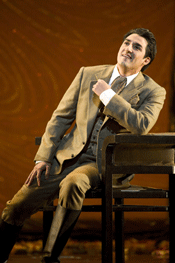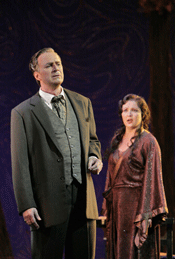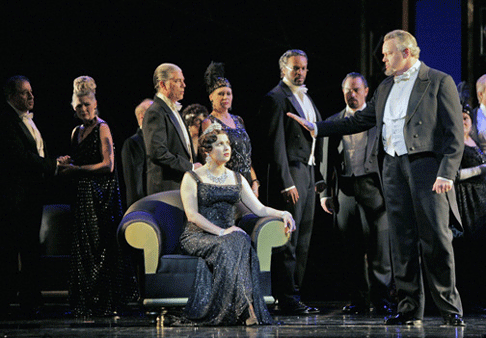Even
the critical intention of finding the positive and ignoring the well publicized
negatives of the production endured only through the first act (overheard
intermission comments “she seems very organized,” “I’ve
seen worse”).
The second act, a Verdi masterpiece, was rendered nonsensical, the
storytelling eviscerated — Violetta flippant, Germont deadly cold,
Alfredo happen chance. Flora’s party was the occasion of an extended
ballet of the sort that makes audiences laugh. Violetta’s death was
enacted in the heavens, possibly a reference, maladroit, to the Eurydice
myth.
 Charles Castronovo as Alfredo [Photo by Terrence McCarthy courtesy of San Francisco Opera]
Charles Castronovo as Alfredo [Photo by Terrence McCarthy courtesy of San Francisco Opera]
If there was ever any theatrical integrity to this production it had
evaporated in this strange encounter of Russian soprano Anna Netrebko, a superb
singer and a very particular artist, with the wife of Placido Domingo. Clearly
there was no connection between the emotional immediacy projected by Mme.
Netrebko, her dramatic delivery of text that was high Monteverdi in its
directness and intensity, and the stylized, content-less staging perpetrated by
Mme. Domingo.
Mme. Netrebko was in fine form for the June nineteenth performance, the
third of her five performances (Elizabeth Futral takes a further three
performances, Ailyn Perez one more). Her voice filled the theater with an
unusual volume and richness, pitch precision sometimes subjugated to
declamation in infinite tonal and rhythmic colorations. It may be noted that
she did not take the ‘Sempre libera’ high E-flat, nor did she open
the traditional cuts in ‘Ah, fors’é lui’ or her ‘Addio
del passato’.
Mme. Netrebko nearly met her match in American tenor Charles Castronovo who
brought urgency, voluptuously sculpted text delivery, beauty of tone and a
handsome stage presence to this Verdi tenor, though like all of them
prototypically unlikeable.
 Dwayne Croft (Giorgio Germont) and Anna Netrebko (Violetta Valéry) [Photo by Cory Weaver courtesy of San Francisco Opera]
Dwayne Croft (Giorgio Germont) and Anna Netrebko (Violetta Valéry) [Photo by Cory Weaver courtesy of San Francisco Opera]
Dwayne Croft, père Germont, possesses a fine instrument that he uses with
great care, and with commendable musicality. Though naturally commanding his
stage presence and musicianship paled in his confrontations with Violetta and
his son when it needed the immediacy and authority to confuse their youthful
impulses.
Reveling in this charged musicality erupting from the stage conductor Donald
Runicles melted into a rapport with the stage that is all too rare in opera,
and when it occurs sublime music is sometimes heard. Mo. Runnicles’
mannered tempi and phrasing were elaborated by those mannerisms of his not
particularly Italianate soprano and tenor, and tempered by the stylistic
cleanliness and musical purity of his baritone. Finally the weeping minor
seconds of Violetta’s death rang incisively, with a final agogic
[a slight withholding of the beat] choke from the throbbing violins —
representative of the Runnicles mannerism catalogue.
 Anna Netrebko (Violetta Valéry) and Dale Travis (Baron Douphol) [Photo by Cory Weaver courtesy of San Francisco Opera]
Anna Netrebko (Violetta Valéry) and Dale Travis (Baron Douphol) [Photo by Cory Weaver courtesy of San Francisco Opera]
It could have been thrilling indeed, this death, had the stage moved in
concert with the Verdi poetic. Mme. Domingo imposed the forms of the roaring
twenties, a metaphor that does not seem to match the atmospheres of this
mid-nineteenth century morality play, perhaps because art nouveau lines are
overwhelmingly sensual, and flashing, reflective surfaces too sexually
forceful. Finally La Traviata is a simple story of family life that
easily disappears in fanciful images (three ballerinas floated onto the stage
to drape Violetta in a bridal gown during the death scene, as one of many
examples).
As this review is for Opera Today and not the Harvard Business
Review the focus is on the art of opera, not the art of business. Perhaps
an evaluation of the business of opera as reflected in this Traviata
and last week’s Tosca would validate some of the artistic
choices, and one hopes, result in more positive terms. Otherwise there can be
no point to San Francisco Opera’s summer season.
Michael Milenski



